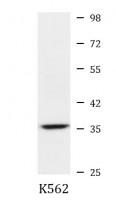ARG57443
anti-Cyclin H antibody
anti-Cyclin H antibody for Western blot and Human,Mouse
Overview
| Product Description | Mouse Monoclonal antibody recognizes Cyclin H |
|---|---|
| Tested Reactivity | Hu, Ms |
| Tested Application | WB |
| Specificity | This antibody detects endogenous levels of Cyclin H and does not cross-react with related proteins. |
| Host | Mouse |
| Clonality | Monoclonal |
| Isotype | IgG2b |
| Target Name | Cyclin H |
| Antigen Species | Human |
| Immunogen | Purified recombinant Human Cyclin H protein fragments expressed in E. coli. |
| Conjugation | Un-conjugated |
| Alternate Names | MO15-associated protein; CAK; CycH; Cyclin-H; p37; p34 |
Application Instructions
| Application Suggestion |
|
||||
|---|---|---|---|---|---|
| Application Note | * The dilutions indicate recommended starting dilutions and the optimal dilutions or concentrations should be determined by the scientist. |
Properties
| Form | Liquid |
|---|---|
| Purification | Affinity purified. |
| Buffer | PBS (pH 7.4), 0.03% Proclin300 and 50% Glycerol. |
| Preservative | 0.03% Proclin300 |
| Stabilizer | 50% Glycerol |
| Concentration | 5.5 mg/ml |
| Storage Instruction | For continuous use, store undiluted antibody at 2-8°C for up to a week. For long-term storage, aliquot and store at -20°C. Storage in frost free freezers is not recommended. Avoid repeated freeze/thaw cycles. Suggest spin the vial prior to opening. The antibody solution should be gently mixed before use. |
| Note | For laboratory research only, not for drug, diagnostic or other use. |
Bioinformation
| Database Links | |
|---|---|
| Gene Symbol | CCNH |
| Gene Full Name | cyclin H |
| Background | The protein encoded by this gene belongs to the highly conserved cyclin family, whose members are characterized by a dramatic periodicity in protein abundance through the cell cycle. Cyclins function as regulators of CDK kinases. Different cyclins exhibit distinct expression and degradation patterns which contribute to the temporal coordination of each mitotic event. This cyclin forms a complex with CDK7 kinase and ring finger protein MAT1. The kinase complex is able to phosphorylate CDK2 and CDC2 kinases, thus functions as a CDK-activating kinase (CAK). This cyclin and its kinase partner are components of TFIIH, as well as RNA polymerase II protein complexes. They participate in two different transcriptional regulation processes, suggesting an important link between basal transcription control and the cell cycle machinery. A pseudogene of this gene is found on chromosome 4. Alternate splicing results in multiple transcript variants.[provided by RefSeq, Nov 2010] |
| Function | Regulates CDK7, the catalytic subunit of the CDK-activating kinase (CAK) enzymatic complex. CAK activates the cyclin-associated kinases CDK1, CDK2, CDK4 and CDK6 by threonine phosphorylation. CAK complexed to the core-TFIIH basal transcription factor activates RNA polymerase II by serine phosphorylation of the repetitive C-terminal domain (CTD) of its large subunit (POLR2A), allowing its escape from the promoter and elongation of the transcripts. Involved in cell cycle control and in RNA transcription by RNA polymerase II. Its expression and activity are constant throughout the cell cycle. [UniProt] |
| Cellular Localization | Nucleus. |
| Calculated MW | 38 kDa |
Images (1) Click the Picture to Zoom In






